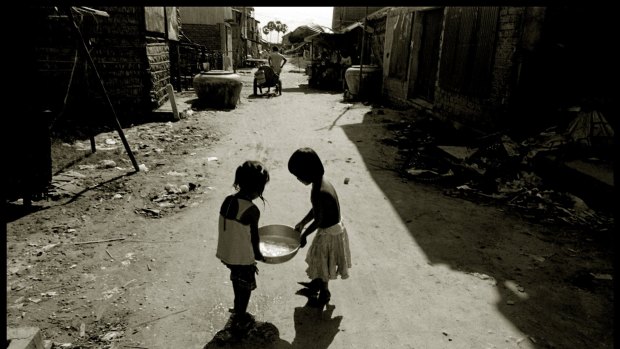This was published 8 years ago
Avoid the handouts: How to help the locals when travelling
By Lee Tulloch

A pair of Cambodian children carry water home after buying it from a cart. Credit: Simon O'Dwyer
The tourism dollars spent in markets and local restaurants do help, but it never feels enough, and isn't. Besides, it's no sacrifice to spend money on things for yourself, especially when you're bargaining hard at a market. I often feel my contributions on the ground are inadequate but I want to do more than donating money at arm's length.
Some travellers are motivated enough to return as voluntourists, giving up chunks of time to physically work on development projects in poor countries. Often there's a fee involved, and the addition of airfares make it a big financial commitment.
With HR managers encouraging volunteer work to enhance resumes and the increasing popularity of volunteer programs with students taking a gap year, voluntourism is now a massive global industry, with about 1.5 million people volunteering each year, according to some British statistics.
In recent times there has been some questioning of the effectiveness of unskilled voluntourists who, in order to have meaningful experiences themselves, may crowd out the good work of locals and even cause heartbreak when bonding with vulnerable people, such as children in orphanages, is only for a short term.
I think the good-hearted people who give up precious months to work on a school building project in Sri Lanka or a literacy program in Africa deserve much respect. Failing that major commitment, though, how do those who are time-poor or burdened with their own responsibilities at home make meaningful contributions to the local community when they travel, apart from packing a few school supplies to donate to local kids (always a good idea)?
I was recently in Cambodia and came across a really wonderful project started by Nhean Samban, "Sam" for short, the Abercrombie & Kent guide who showed my group around Siem Reap. Sam survived the Khmer Rouge regime and in the aftermath began work as a waiter in 1989 at the Grand Hotel D'Angkor, now Raffles. Even though he had no formal education until age 12, he graduated from university at 40, completing a degree in tourism, and began escorting wealthy Westerners around his city. He is one of Siem Reap's most popular guides.
Returning to his village in 2004, he was appalled by the lack of clean water, which caused major sicknesses, such as typhoid and cholera among the villagers. The children were constantly sick from drinking water collected in shallow receptacles. He decided to do something about it.
He hired a contractor to drill a 100-metre deep well (bacteria can't survive below 12 metres) and bought a hand pump. The first well cost $260 and soon he built two more in the village. By 2006, he'd built 40 wells in the region, in partnership with his brothers. He raised funds from collecting donations from the tourists he guided, many of whom were gratified to have an opportunity to give something back.
Thanks to Sam, there are now more than 950 clean water drinking wells throughout Cambodia. The cost of each well has risen to $460, but for well-heeled A&K travellers, it's much less than the cost of one day on the trip. One Hollywood identity ordered 110 wells as Christmas gifts.
When the wells are built, Sam sends photographs of the well to donors, who are encouraged to make follow-up visits to see how effective their money has been. Abercrombie & Kent now includes Sambrothers Clean Water Project as part of its philanthropy program. Sam also operates a dormitory for poor rural children who want to study in the city. (To donate, see sambrothers.org).
Sam tells me many of his fellow guides have copied his model and have created their own programs in health and education, using their privileged access to visitors as a way of raising funds. It's win win: concerned visitors have the opportunity to donate to local projects that are vital and have a direct effect on communities. Communities benefit from funds for a specific purpose, without involving massive amounts of red tape.
Being a good guide is not merely about reciting the history of monuments, but forming that cultural bridge between visitor and host. When it involves generosity on both sides, it's a wonderful thing. To find out how to help, start with asking your tour guide.
Lee Tulloch was a guest of Abercrombie & Kent.
Sign up for the Traveller Deals newsletter
Get exclusive travel deals delivered straight to your inbox. Sign up now.